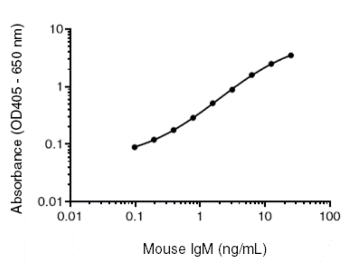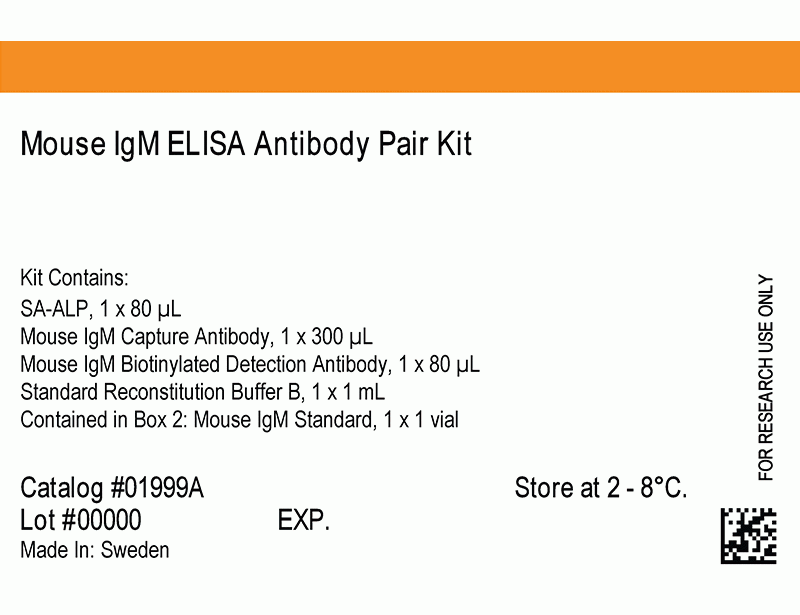Mouse IgM ELISA Antibody Pair Kit
For detection and measurement of mouse immunoglobulin M
概要
The Mouse Immunoglobulin M (IgM) ELISA Antibody Pair Kit is intended for those who want the flexibility of setting up their own ELISA assay. This kit includes capture and detection antibodies and an IgM standard. It is designed for the quantitative detection and measurement of mouse IgM in biological fluids such as serum, plasma, and cell culture supernatants. IgM is predominantly found in lymph fluid and in blood where it acts as a neutralizing agent in the early stages of infection. Secreted IgM exists in a pentameric form whereas monomeric IgM is found on the surface of B cells. IgM constitutes approximately 10% of all serum immunoglobulins.
The assay is based on the sandwich ELISA method, in which samples are added to ELISA plates coated with capture antibodies specific for the immunoglobulin. The captured immunoglobulin is detected by addition of a biotinylated detection antibody, followed by streptavidin-alkaline phosphatase (SA-ALP), which binds the biotinylated antibody. Addition of the chromogenic enzyme substrate p-nitrophenyl phosphate (pNPP) results in a colored product with an intensity directly proportional to the concentration of immunoglobulin in the sample. The concentration of the immunoglobulin is determined by comparison to a serial dilution of the immunoglobulin standard analyzed in parallel.
NOTE: This kit includes sufficient reagents for 6 x 96-well ELISA plates (Catalog #38019). ELISA plates and pNPP Substrate (Catalog #01917) are required for use with the Mouse IgM ELISA Antibody Pair Kit and are available for purchase separately.
The assay is based on the sandwich ELISA method, in which samples are added to ELISA plates coated with capture antibodies specific for the immunoglobulin. The captured immunoglobulin is detected by addition of a biotinylated detection antibody, followed by streptavidin-alkaline phosphatase (SA-ALP), which binds the biotinylated antibody. Addition of the chromogenic enzyme substrate p-nitrophenyl phosphate (pNPP) results in a colored product with an intensity directly proportional to the concentration of immunoglobulin in the sample. The concentration of the immunoglobulin is determined by comparison to a serial dilution of the immunoglobulin standard analyzed in parallel.
NOTE: This kit includes sufficient reagents for 6 x 96-well ELISA plates (Catalog #38019). ELISA plates and pNPP Substrate (Catalog #01917) are required for use with the Mouse IgM ELISA Antibody Pair Kit and are available for purchase separately.
Components
- Mouse IgM Capture Antibody, 300 µL
- Mouse IgM Biotinylated Detection Antibody, 80 µL
- SA-ALP, 80 µL
- Mouse IgM Standard, 1 vial
- Standard Reconstitution Buffer B, 1 mL
Subtype
Antibody Pair Kits
Cell Type
B Cells, Hybridomas
Species
Mouse
Area of Interest
Hybridoma Generation, Immunology
技术资料
| Document Type | 产品名称 | Catalog # | Lot # | 语言 |
|---|---|---|---|---|
| Product Information Sheet | Mouse IgM ELISA Antibody Pair Kit | 01999 | All | English |
| Safety Data Sheet 1 | Mouse IgM ELISA Antibody Pair Kit | 01999 | All | English |
| Safety Data Sheet 2 | Mouse IgM ELISA Antibody Pair Kit | 01999 | All | English |
| Safety Data Sheet 3 | Mouse IgM ELISA Antibody Pair Kit | 01999 | All | English |
| Safety Data Sheet 4 | Mouse IgM ELISA Antibody Pair Kit | 01999 | All | English |
数据及文献
Data

Representative Standard Curve
• Reportable Range: 0.1 - 25 ng/mL. This is the concentration range in which measurement of the analyte can be done with the highest precision, accuracy, and linearity.
• Accuracy: No international standard exists for calibration.


